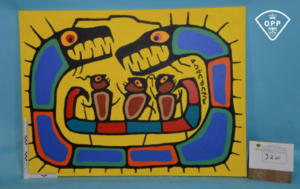In what some call the dismantling of the world’s biggest art fraud conspiracy, police in Ontario arrested eight people last Wednesday in connection to an art forgery scheme responsible for creating thousands of fake works and passing them off as originals by the Canadian indigenous artist Norval Morrisseau.
Morrisseau was an incredibly influential indigenous artist who was a member of the Professional Native Indian Artists Incorporation, commonly known as the Indian Group of Seven. This group was mainly made up of seven indigenous artists, including Morrisseau, Jackson Beardy, Daphne Odjig, and several others, and are often credited with bringing indigenous art into the mainstream in Canada. Morrisseau passed away in 2007, but even while he was alive, he was incredibly concerned about forgeries of his work, founding the Norval Morrisseau Heritage Society (NMHS) to counteract this. Morrisseau forgeries are commonplace mainly because, until the founding of the NMHS, the artist never kept track of his work or created a catalogue. People who knew him in Ontario speak of how he would trade paintings for groceries in his early career. This particular large-scale forgery ring had been operating since 1996 in Thunder Bay, Ontario, and was brought down because of a documentary film and a related cold-case murder.
Detective Sergeant Jason Rybak of the Thunder Bay Police Service said that he was looking into the unsolved 1984 murder of Scott Dove when he came across the documentary There Are No Fakes, directed by Jamie Kastner. The film follows the story of Kevin Hearn, the keyboardist of the band the Barenaked Ladies, and his lawsuit against the Maslak McLeod Gallery in Toronto after selling him a fake Morrisseau painting. About five months after the documentary's release, Hearn was awarded C$60K (or US$45K) by the Ontario Court of Appeal after the gallery failed to prove the painting was by Morrisseau. When Sergeant Rybak saw the documentary, he found that one of the people named as one of the biggest producers of Morrisseau forgeries in Canada was one of the main suspects in Scott Dove’s murder. The documentary describes Gary Lamont as a local gangster and a drug dealer who has also been repeatedly convicted of sexual assault over the past thirty years. The arrested group of eight, which included Lamont, are accused of operating a sort of forgery assembly line to create fake Morrisseau works. The group recruited indigenous artists, sometimes paying them with alcohol and drugs, to create works in Morrisseau’s style. One of the eight arrested was Benjamin Paul Morrisseau, the artist’s nephew. Because the NMHS was not founded until 2005, there was no central authority to clamp down on the proliferation of these forgeries. Over the years, works from Lamont’s group started making their way into galleries across Canada, with some being sold overseas in China, Germany, and the United States. Some estimate that there are probably ten times more forgeries than legitimate Morrisseau works on the market today and that there might be Morrisseau forgeries held in the Smithsonian collection.
Norval Morrisseau is now known today as one of Canada’s greatest artists, with some calling him the Picasso of the North. So clearly, those who knew him and those who work to maintain his legacy are outraged by these revelations. The executive director of Morrisseau’s estate Cory Dingle said, “one of the world’s greatest spiritual and cultural icons of Canada in the Indigenous community has been defrauded.” The police have since confiscated over a thousand paintings, prints, and other works. Each of these works was sold to their current owners for tens of thousands of dollars, meaning that over the years, the forgery ring must have made close to $100 million. Ontario police suggest that those who may have bought fake Morrisseau works seek legal counsel, and that the Law Society of Ontario’s referral program offers a free half-hour legal consultation.

